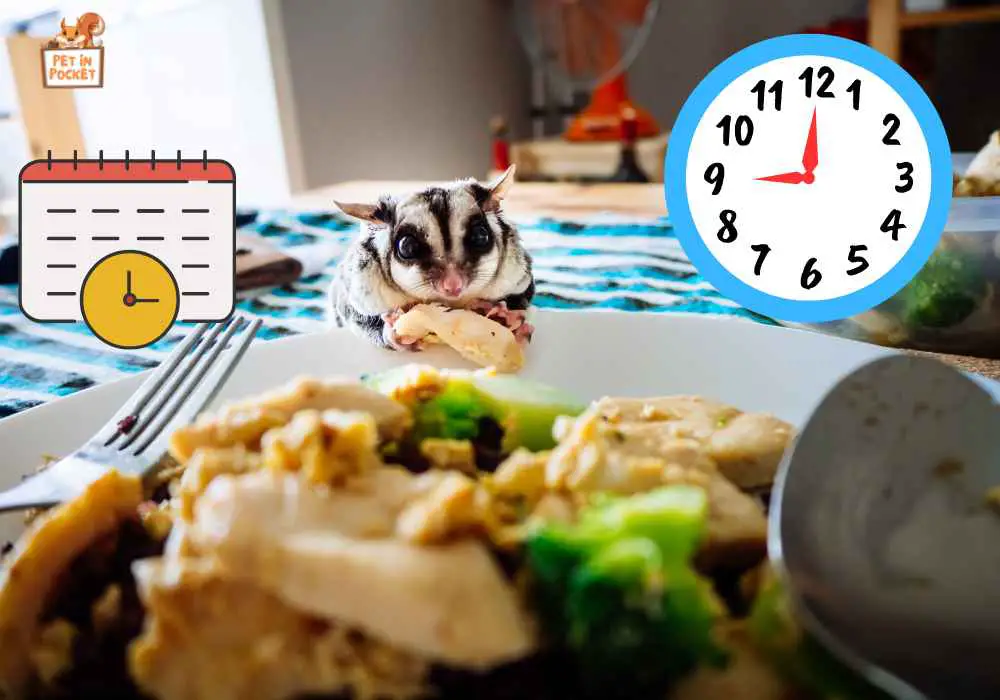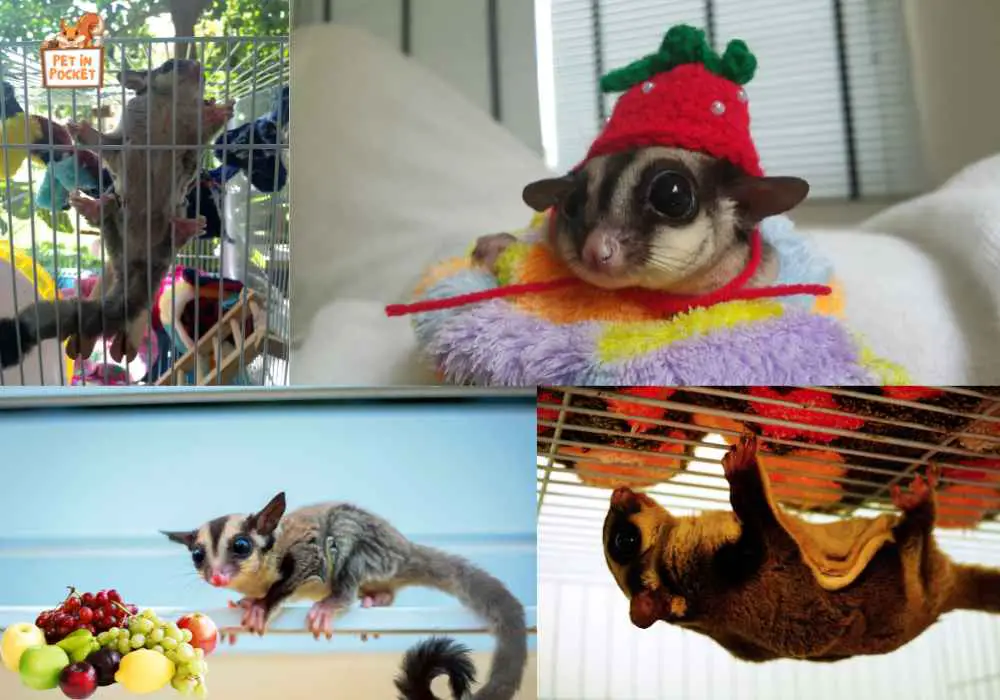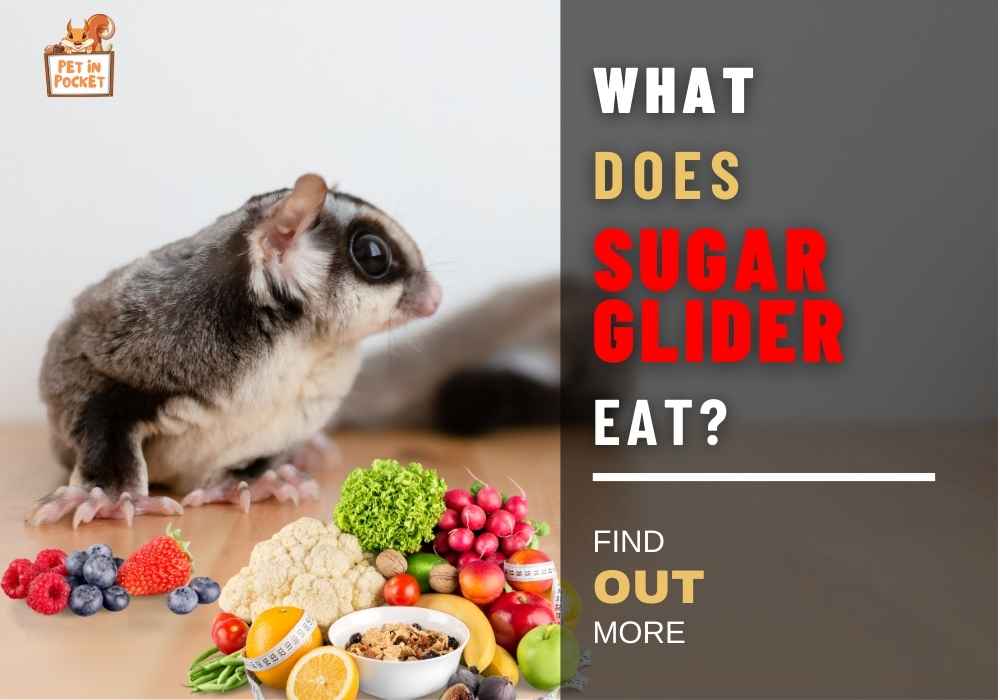Sugar Glider eats eucalyptus leaves, honeydew, fruits, vegetables, protein-packed insects, sap, gums, leafy green and flower nectar. As a pet owner, it is important to provide your sugar glider a balanced diet that closely imitates their natural eating habits.
Sugar gliders are small, adorable and playful marsupials. These nocturnal furry being is native to Australia, Indonesia and Papua New Guinea. Sugar Gliders are known for their love to sweet foods. Besides, this joyful and tiny creature has unique dietary needs. Sugar Gliders are omnivorous. In the wild, they usually eat mixture of vegetation and protein.
As an owner you have to understand what does sugar glider eat, the best food option for their health and physical activity, which foods do harms to their body and how to ensure your furry friend is happy.
Table of Contents
Sugar Glider’s Natural Diet
Naturally, sugar gliders are omnivorous. That means they eat both plant and animal originated food. In the wild their diet usually consists of:
- Honeydew and Sap from trees
- Protein-packed Insects and spiders
- Pollen and nectar from flowers
- Fruits and flowers
- Small birds, bird eggs and lizards (occasionally)
Sugar gliders have an updated digestive system. They can extract nutrients from their diverse diet plan. They have a prolonged cecum. Cecum is a part of the large intestine. It helps them in breaking down the complex plant ingredients.
Healthy diet for your Sugar Gliders

A sugar glider diet should be a delicate balance of fruits, vegetables, proteins and vitamins. Naturally in the wild, they eat variety of food which cannot be mirrored exactly at the home of an owner. So, variety of food in their diet plan can mitigate the gap as possible as of their natural diet. This mixture of food ensures that they get proper nutrients for their healthy life.
Everyday a Sugar Glider needs to eat 15-20% of their body weight. A balanced diet provides necessary ingredients they need to survive and their well-being. Sometimes collaborating with a veterinarian for diet plan works fine.
| Fruits such as apples, pears, watermelon, papaya, orange and grapes. |
| Vegetables like carrot, sweet potatoes, green beans and succumbed seeds |
| Boiled egg, lean meats, pellets for protein sources |
| Vitamin and mineral supplements |
Foods to Avoid for Sugar Gliders
There are some foods that can be harmful or even toxic to sugar gliders health. When you are preparing a balanced diet of your pocket pet you should avoid foods that contains high amount of sugar, pesticides or excessive Phosphorus. High amount of phosphorus can lead to calcium deficiency. You should avoid these to feed your Sugar Glider:
Chocolate and Caffeine are toxic to sugar glider. Onion and Garlic can create digestive issues. Dairy products and sugary treats contain high level fat which can lead to obesity related issues for a sugar glider. Moreover, you have to pay attention onto their preferred temperature range, feeding habits and nutritional needs.
Essential Foods for Sugar Gliders

A healthy diet for sugar gliders must include a variety of fresh fruits, vegetables and small amount of protein-packed food. In the wild, they take about ¾ portion of their food from gums, saps, pollen and nectar,the other ¼ comes from insects, baby birds, eggs etc.
During captivity a Sugar Glider cannot get food by itself. So, the owner has to make a diet that replicate as closely as to their natural eating habit. Otherwise, it would cause a bad impact on Sugar gliders health. Always make sure that your food is fresh and free from contamination. A well-balanced sugar glider diet should include:
High-Protein Staples
- Specially formulated high-protein diet for sugar gliders (available at the pet stores)
- Insects like bugs,crickets, mealworms, and grasshoppers; these can be alive, frozen or dried. Don’t feed insects that you picked from outside, it may contain harmful ingredients.
- Hard-boiled eggs
- Yogurt, cottage cheese, peanut butter and tofu
- Cooked lean meats of chicken, turkey, or beef
These small creatures need protein sources to meet their nutritional needs. Amino Acid is also vital for them to maintain a healthy body weight.
Fruits and Vegetables
- Fresh fruits like apples, berries, pears, grapes, watermelons,papaya and bananas, while being cautious with high-sugar containing fruits.
- Leafy green vegetables like spinach, kale, broccoli, cabbage and dandelion greens etc.
- Vegetables carrots, sweet potatoes, squash, green beans for extra nutrition.
Nuts and Seeds

- Nuts like almonds, walnuts, or pecans; they should be unsalted
- Seeds such as sunflower seeds and pumpkin seeds for moderation.
Supplements
- Calcium powder
- Vitamin supplements designed for sugar gliders
- Dust their food with calcium powder to ensure proper bone health.
- Provide a suitable multivitamin supplement to fill any nutritional gaps in their diet.
Always ensure a fresh and clean water source is available for the sugar gliders. Sugar Gliders are highly active animal and you should put all the necessary foods every time.
To prevent health issues like obesity and dental problems you should moderate the diet. It is also important to wash the fruits and vegetables accurately to remove any pesticides or contaminants.
While sugar gliders can be pampered with a variety of fruits so it is essential to avoid feeding them fruit juice, honeydew, or nectar. Proteins and insects are essential elements in a sugar glider’s diet.
But they should be balanced with other food and supplements. Better if you consult a veterinarian regarding the proper feeding to ensure that the sugar glider’s dietary needs are met.
Schedule for Sugar Glider to eat in a healthy way
Food should be available to your sugar glider any time throughout the day or night. Feed your Sugar Glider once or twice in a day. Some owner feed their Sugar Glider only at the dusk, some feed their pet twice in a day. After providing the food at dusk many individuals opt to replace the food in the morning. Because the gliders have consumed it during the night and returned to rest and if the glider wakes up in the middle of the day it would like to eat.
The schedule for sugar glider also depends on how many times your Sugar Glider prefers to eat. If you have habituated it eating in one time only, then you should provide food at the dusk every-day.

Sugar Gliders are highly active and energetic animal. Sugar gliders have a very fast metabolism process that’s why they require frequent meals. If they seem hungry you can serve them extra food otherwise you can increase the food amount.
In the wild, they eat throughout the night. There they can mitigate their demand for food as much as they want. During their captivity the responsibility is now yours. As a pet owner, you should maintain a schedule diet for them.
The Importance of a Balanced Diet
A well-balanced diet is crucial for your sugar glider’s health and well-being. Proper nutrition can make them strong and cheerful. It also increases their healthy growth and mental development. Balanced diet helps sugar glider to maintain a strong immune system.
Sugar Glider has sweet teeth, improper diet like high sugary foods can damage their dental health. Balance diet promotes good dental health, prevents obesity and other health issues. It improves their quality of life.
Enrichment and Foraging

With a diet plan it is also important to offer your sugar glider opportunities for enrichment and foraging. These enrichment activities stimulate your sugar gliders natural foraging instincts. It provides mental stimulation for their stability. For enrichment and foraging you can:
- Hide food in their toys or puzzle feeders
- Play with them with foods
- Scatter food throughout their cage
- Offer live insects for hunting (under supervision)
What should maintain for a proper diet to Sugar Glider?

Sugar Gliders are pretty sensitive in terms of food. If any Sugar Glider consumes unhealthy meal, they face various health issues. As a pet owner you have to assure your Sugar Glider a well-balanced diet. It will prevent their potential health complications. Here are some important dos and don’ts to consider in Sugar Gliders diet:
Pros
Cons
Frequently Asked Questions
What are sugar gliders main food?
In the wild, sugar glider eats eucalyptus leaf, tree gums, bird egg, little bird, sap, nectar and insects. Fresh fruits, vegetables, insects, lean meat, boiled egg and nectar etc. is their main food.
What food sugar gliders should avoid?
Sugar gliders should avoid high-sugar foods, chocolates, caffeine, raw meats and fatty food. It causes harm to their body. High fatty foods create obesity and related health issues.
How often do sugar gliders eat?
Sugar Gliders eat once or twice in a day. The meal can be provided in the morning and in the night or only at the dusk. It depends on the owner. Some feed their sugar glider once and some does it twice in a day.
What is the best diet for sugar glider?
Sugar Gliders love to eat sweet foods. Sugar Gliders diet in captivity should include protein staples, nectar, insects, fruits and vegetables.
How much should I feed my Sugar Glider?
The amount of the food depends on the size, age and the activity level of the sugar glider. They consume 1-2 tablespoon food every day. You can split this into two meals.
Conclusion and final thoughts
Food should be accessible to your sugar glider 24/7. As a pet owner, you have to provide a well-balanced and nutritious diet for your sugar glider to improve its overall health and wellbeing. To keep them healthy and strong, replicating their natural diet is key.
Sugar gliders have a diverse diet. In the wild they eat tree sap, nectar and insects. Feeding them variety of fruits, vegetables, proteins, and insects in captivity can mirror the natural diet closely. Otherwise, it won’t be sufficient to meet their nutrition demand. Avoid certain foods like pit fruits, chocolates, caffeine, raw meats, fatty and high sugar food. These are harmful to sugar gliders health.
The wrong food can do harms to sugar gliders health. So, it is important to educate yourself first about Sugar Gliders diets and health. You have to understand their preferences and choices to keep the joyful little creature happy.






Leave a Reply